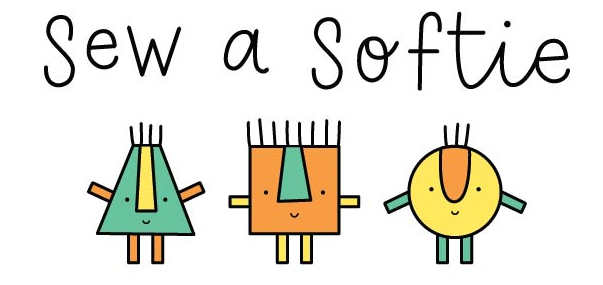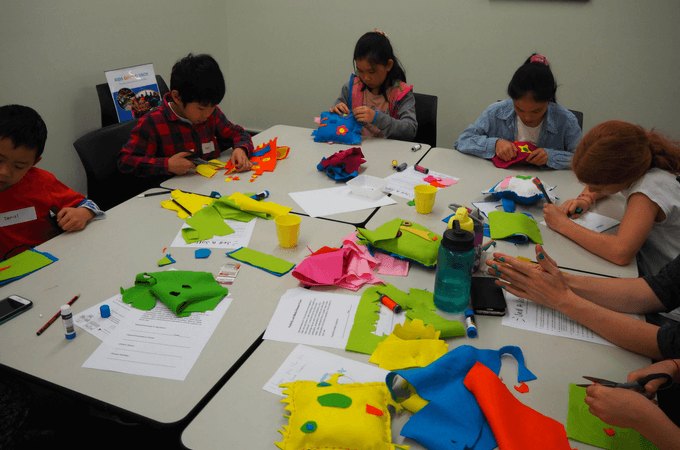The 7 golden rules for teaching kids to sew that I’ve learnt over the past 25 years.
Teaching kids to sew over the past 25 years has taught me never to underestimate the capabilities of a child who really really wants to do something.
Over those 25 years I often ran sewing workshops that started at 10am and finished at 3pm. The children who came ranged from as young as 5 year olds to 13 or 14 year olds with most students somewhere in the 7 to 10 year old range. Why am I telling you this? Because most adults will tell you that 5 year olds can’t sit and concentrate for that many hours on a single project. And they’re probably right in most cases…but not when it comes to sewing.
When these kids come to a sewing workshop and start sewing that lack of concentration miraculously vanishes. They just want to sit and sew. They do complain though….they almost always complain when it’s time for a break. I really do have to insist. When I tell them that they have to put their sewing down and go outside for 15 minutes mid-morning to stretch and relax and later for 30 minutes to eat lunch and run around a bit….they’re not very happy. I have to confess, that’s the sort of complaining I like.
My point here is simple: if you want to see just how well your child can concentrate, give them a simple-to-sew project. Here are some easy hand sewing projects for teaching kids to sew .
Andyou might like my latest book, The Zenki Way: A Guide to Designing & Enjoying Your Own Creative Softies.
You might find yourself as surprised as I was 25 years ago…and after you’ve mastered these 7 golden rules for teaching kids to sew you might want to check out the 5 golden don’ts of teaching kids to sew…just in case!
7 Golden Rules for teaching kids to sew.
1. All stitches are good stitches.
I don’t get kids to undo big or messy stitches. I’m happy for them to just get the hang of sewing in a positive way. I show them how to get smaller neater stitches. I explain why we need to have small stitches (so the stuffing doesn’t fall out) but I just let them stitch away. With a bit of practice their stitches do become more controlled and get smaller and neater.
2. Let the kids make the decisions.
If the kids ask for my advice on a decorative matter I try to get them to work out what they think would look good. I want them to think about the choices and decide what they like. They begin to realise that when it comes to design and decoration there’s no wrong answer. They learn to trust their own choices. Often children have the idea that an adult can make a better choice. Sewing their own projects brings the realisation that their own choices are the ones that matter not someone else’s.
3. Copying is good
When the kids aren’t sure how they want to design or go forward with their project I get them to look at what other kids in the group are doing to get ideas. It’s great to look at others work for inspiration and for kids to realise that theres nothing wrong with getting ideas from others. Sewing is an inter-dependent creative activity not a competitive one.
4. This isn’t a race
I always tell the kids it doesn’t matter if they sew slowly or quickly. Everyone will finish their project by the end of the workshop. I want them to enjoy the sewing and not think that finishing first or trying to out-do others is something they should be striving for in their sewing.
5. Every softie needs a baby
I learnt this most important rule early on. We were sewing koala softies. I shrunk the template down so that early finishers could sew a baby softie in the time they had left. Well, no-one wanted to leave that workshop without first sewing a baby koala. Needless to say, there was some frantic sewing going on in the last minutes of that workshop in order to make sure that their baby koala was finished with all their decorative touches before they went home.
6. Less may be good but more is much better
What can I say, young children don’t like holding back. It is true that sometimes I have needed to put some limits on the number of bows, diamantes, etc that they want to use on their project so that we still have enough for everyone else in the workshop to use.
7. Chocolate crackles are a great way to end a workshop
Chocolate crackles are one of those uniquely Australian foods that are a staple at any self-respecting party…well, at least they were when I was growing up. I always make a batch of chocolate crackles as an afternoon snack for students in my workshops. The ‘chocolate crackle at the end on the workshop’ rule was born and every child knew, even if they had never been to my workshop before, that those chocolate crackles were coming.
So the last rule is really: make sure that your sewing is something your kids will see as exciting and fun.
And if you’d like to start teaching kids to sew have a read of my Essential Guide to Teaching Kids to Sew.
Happy sewing, Trixi



What a brilliant set of tips Trixi. Thanks for sharing!
Your blog warmth my heart, I’m a Mom. I’m so into sewing machines, but I always over anxious using machine.
For so many years I feel “I’m not good enough” Because I don’t have or use machine just like everyone else.
But you convinced me somehow… Thank you..
Do you always cut out their project pieces for them with beginners?
I’ve been asked to teach a young Girl Scout groups in the future and want it to be a positive experience.
It all depends on the project, the age, the amount of kids but basically if I don’t know the group or their abilities, Yes I cut out the pieces but I also have lots of scrap felt available for kids to cut out their own pieces so they can change the design. I want sewing to be a positive experience and for the kids just to get the hang of sewing and enjoy it.
Overwhelmed. Looking to buy my granddaughter, age 8, her first sewing machine—Where to start other than all the one star reviews on all sewing machines.
Wisdom available free?
Hoping to rid her world of video games ; )
MiMi